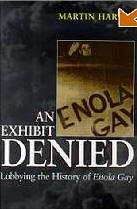
 |
|
|
 |
Click Here to Buy the book,
"An
Exhibit Denied"
Lobbying
the History of Enola Gay
Hardcover Book
ISBN-10: 0387947973
B-29
Superfortress Books
B-29
Superfortress Movies B-29
Models
Martin Harwit's An Exhibit Denied is a cautionary tale about what happens when politics intrudes on the objective quest for truth. The year 1995 marked the 50th anniversary of the flight of the Enola Gay, the plane that dropped an atomic bomb on Hiroshima. In preparation for that anniversary, the Smithsonian Institution's National Air and Space Museum began work on an exhibit that would not only reprise the events surrounding the bombing, but would also examine the bomb's impact on people--both Japanese and American, civilian and military. Under the guidance of Martin Harwit, a former professor of astrophysics at Cornell University, the planned exhibit included, among other things, Japanese civilian artifacts from the bombing and documents showing that high-ranking military leaders such as Dwight D. Eisenhower had grave doubts about dropping the bomb. Most controversially, the exhibit did not support the commonly held belief that the bombing saved countless lives by preventing a land invasion, and this is what eventually led to its downfall. Harwit pointed out that there was no way of knowing how the war would have ended without bombs; the American Legion national commander demanded that President Clinton shut the exhibit down. What followed was a donnybrook of epic proportions as the media, the Republican-dominated Congress, and veterans' lobbying groups all portrayed Harwit's attempt to present the Enola Gay in an objective light as antipatriotic, left-wing propaganda. Eventually, Harwit was dismissed and the Enola Gay exhibit was drastically rewritten. In An Exhibit Denied, Martin Harwit once again brings his scientific method to the telling of this story, presenting both sides of the argument and letting the facts speak for themselves. What those facts tell us is truly disturbing. |
|
The Smithsonian Air & Space Museum's attempt to mount an exhibit featuring the Enola Gay, the bomber that dropped the atomic bomb on Hiroshima, broke down in a firestorm of controversy. A national campaign by veterans' groups led to intense media criticism and ultimately to Congressional scrutiny, cancellation of the exhibit, and the resignation of the museum's director, Martin Harwit. That the nation's most popular museum was prevented from addressing the most important military action of this century is a signal cultural event of our time. Harwit's beautifully written and extensively documented book tells what really happened, from the initial decision to restore Enola Gay, through the breakdown of cooperation, to Smithsonian Secretary Michael Heyman's announcement, on cancelling the exhibit, that "we made a basic error in attempting to couple an historical treatment" to a patriotic commemoration of the war's end. Whatever you think of the atomic bombings in World War II, our modern culture wars, or the recent spate of controversies surrounding museums, this book will enlighten and change your views. |
Learn About North Pole Travel and Global Warming, What You Need To Know
| . |